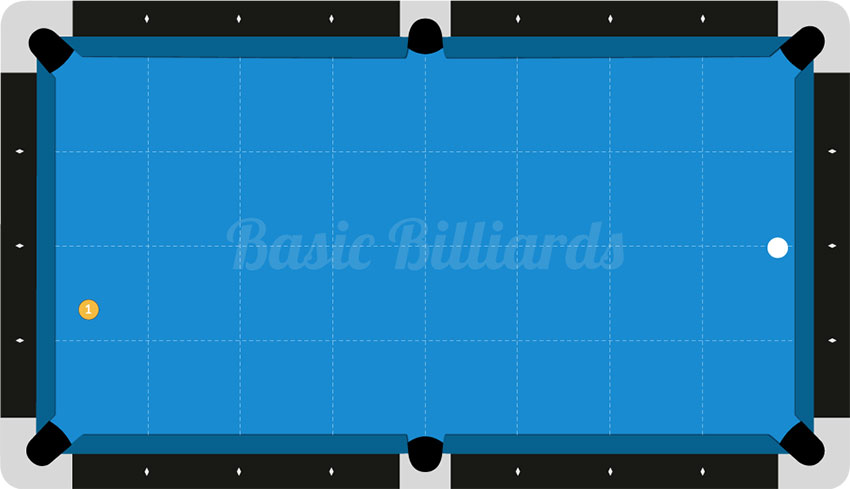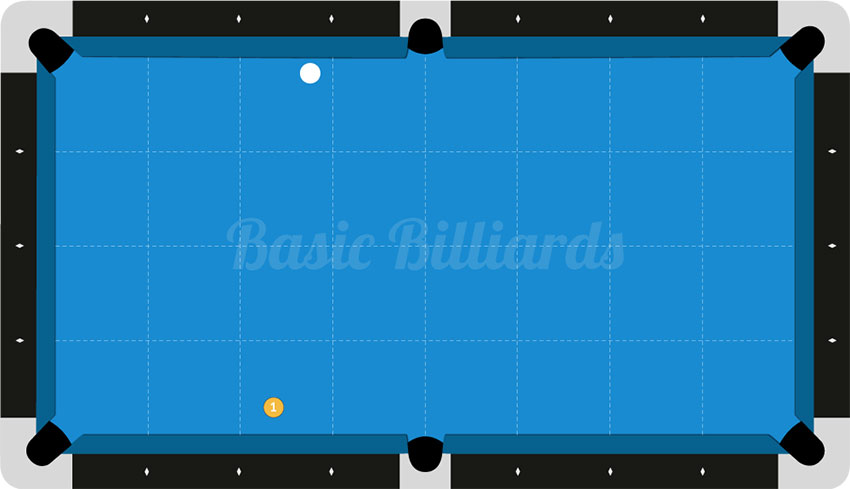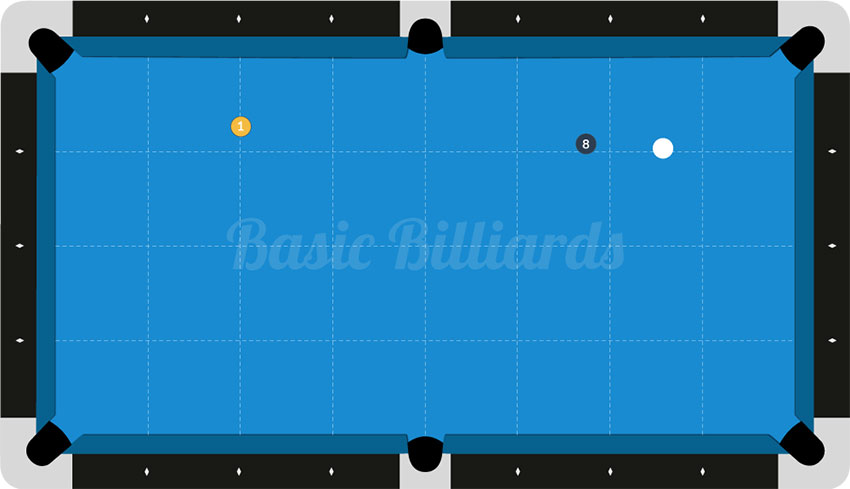There are three main types of safeties that you can play to go on defense. The best-case scenario is to hide the cue ball behind an object ball, but this isn’t always possible depending on the layout of the balls on the table. That’s when knowing what kind of safety to play can come in handy.
- Create distance between the cue ball and object ball
- Put the cue ball and object ball in the middle of opposite rails
- Block the cue ball from a direct path to the object ball
An ideal safety contains all three of these elements, however if you can successfully accomplish one or two of these goals you have a good chance of another shot at the table.
Creating Distance
Probably the easiest way to play safe, especially when you’re starting to play the game, is to create distance. In most cases creating distance involves controlling the object ball and putting it at the opposite side of the table. Distance is a powerful tool because the farther away the cue ball is from the object ball more precision is needed to hit the object ball accurately. You need to have a good stroke, sight the ball correctly, and account for swerve which is harder to gauge at long distances and limits your opponent’s options. Using left and right english increases the variables to any shot so when you increase distance you are making it much more difficult to precisely use english which increases the risk of certain shots your opponent might play.

Middle of Opposite Rails
An effective way to create a safety is to put both the object ball and cue ball in the middle of opposite rails. This means you can put them in the middle of the head rail and foot rail which is a good safety for a couple reasons. The primary reason is that it’s hard to pocket the object ball. The only ways to make the ball is to either try banking the ball, which is a legitimate shot in some cases, or kick it in. Both options are high risk, so the most common response to this kind of safety is another safety.
On top of that when you place the cue ball directly on the rail you take away even more options. First off, it’s hard to cue a ball on the rail for anyone, and it takes good fundamentals to play shots off of a rail. By placing the cue ball on the rail your opponent can only see the top of the cue ball which makes it hard to use english or draw. This takes away a whole slew of shots that could be played which can give you the upper hand in a match, so whenever possible, try to put the cue ball against a rail or another object ball.
This safety doesn’t have to only be played on both the end rails. You can play this shot with the cue ball and object ball on opposite sides of the long rails of a pool table as well. The benefits of this is that the object ball is still difficult to pocket, but since the cue ball is much closer, it’s easier to bank or play an offensive safety. Playing this type of middle rail safety is a containing shot that makes it risky for your opponent to play an offensive shot, but easier to play an offensive safety. So, don’t be surprised if the next time you come to the table your shot is less than ideal. Having said that, this shot is still totally legitimate depending on the circumstances, so keep your eye out for this safety if you feel like you’re out of good options.

Object Ball Safety
The king of all safeties is the object ball safety. When you can block a direct path the object ball by hiding both the cue ball and object ball behind one ball or a cluster of balls your opponent’s only options are to kick or jump to hit the object ball. This increases your chances of coming back to the table which an easier shot or, hopefully, ball in hand. Of course, this doesn’t always happen. In pool you must be prepared for a certain degree of luck in the game. You opponent could pocket their ball, or they may just hit it and somehow leave you in a worse position than you just left them. Don’t get mad if this happens, it’s part of the game. You can only play the percentages so well in any game.
This is the exception though, not the norm. Generally, when you perform an object ball safety you will end up with a better shot than you had previously or an opportunity to play another aggressive safety. The reason this type of safety is more difficult is because you need to have precise control of BOTH the object ball and the cue ball to hide them behind cover. The reason for this is you need to know where the cue ball will rest so you know where to put the object ball to hide it. Playing an object ball safety takes more knowledge than the other two types of safeties since there are so many ways to play this shot and you need to have a good feel of the speed of both object ball and cue ball.
It’s a good idea to practice hitting an object ball with your cue ball and trying to put the object ball in a specific place on the table to get a feel for controlling object ball speed. This will give you a better feel when playing these shots in the middle of a match.

